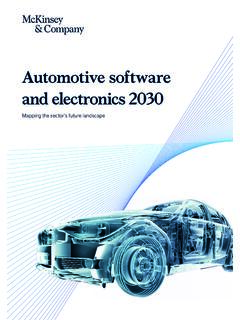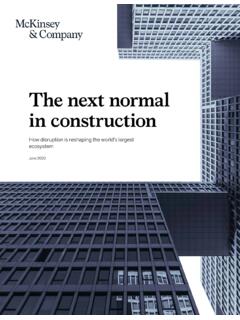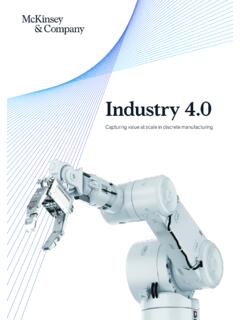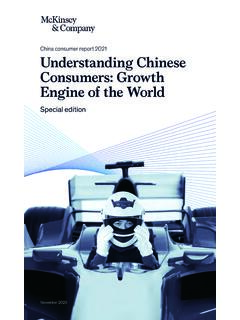Transcription of Future of retail operations: Winning in a digital era
1 January 2020 This compendium explores the breadth of change and risk throughout the modern retail of retail operations: Winning in a digital eraCover image: adventtr/Getty ImagesCopyright 2020 McKinsey & Company. All rights reserved. This publication is not intended to be used as the basis for trading in the shares of any company or for undertaking any other complex or significant financial transaction without consulting appropriate professional part of this publication may be copied or redistributed in any form without the prior written consent of McKinsey & operationsSupply chain 522161131A transformation in storeBrick-and-mortar retail stores need to up their game. Technology could give them a significant schedules, better budgets: How to improve store operationsThrough activity based labor scheduling and budgeting, retailers can become more efficient while improving customer service and employee the cost curve in brick-and-mortar retailRetailers can achieve next-generation store efficiency by breaking down silos and optimizing total cost across the value chain of the Future : Key principles in building an omnichannel distribution networkAs omnichannel shopping is becoming the new norm, consumer and retail companies must be ready to deliver fast, impeccable omnichannel service.
2 Doing so requires a new supply chain network retailer s guide to successfully navigating the race for same-day deliverySame-day delivery: Consumers expectation for same-day delivery is rising and putting pressure on retailers supply service with connected inventoryIt is not just the customer experience that manufacturers and retailers enhance by extending their reach to the entirety of stocks in the >1,000,000 Inhabitants>500,000 1,000,000>200,000 500,000 Warehouse coverageRetailer same-day oering in top 20 citiesAmazon vs top 20 non-food and top 13 grocery retailers Same-day coverage of relevant population, Amazon vs disguised omnichannel fashion retailerbytype of competition, %28 stores across Germany, covering 5 ofGermany s 20 biggest citiesOngoing testing and buildup ofship-from-store capabilitiesCompetition area (Amazon and retailer )Area at risk(Amazon only)Retailermonopoly area( retailer only)Source: Alteryx; BKG; ESRI ArcGIS; MB-Research.
3 McKinsey analysis 1 Relevant population areas de ned as high density (>750 inhabitants/km ) and/or high income (purchasing power > 21,900 per capita); viable market coverage de ned as area within 30 minutes driving time from respective retail power coverageViable market coverage for same-day delivery via ship from store %1 Relevant population areas de ned as high density (>750 inhabitants/km ) and/or high income (purchasing power > 21,900 per capita); viable market coverage de ned as area within 30 minutes driving time from respective retail : Alteryx; BKG; ESRI ArcGIS; MB-Research; McKinsey analysisStore locationBerlin1 Beyond procurement: Transforming indirect spending in retailIf retailers treat indirect costs as an opportunity for business transformation rather than just a procurement matter, they can boost return on sales by as much as 2 procurement in retailFor retailers, procurement is no longer solely a matter of negotiating A brands.
4 Private labels and verticalization are trending. Advanced approaches and tools help get procurement in shape for the emerging trends in facilities managementOutsourcing, workplace strategies, and technology innovations hold immense potential for companies seeking to reduce costs and improve productivity in facilities end of IT?Retailers who want to stay ahead of the pack and drive business results through technology innovation are rethinking the setup of their IT in logistics: Big opportunity, bigger uncertaintyAs e-commerce volumes soar, many logistics and parcel companies hope that automation is the answer. But as this second article in our series on disruption explains, things are not so generation supply chain transforming your supply chain operating model for a digital worldIn a digital age, most supply chains run on old principles and processes. A few leaders can show us how a new operating model can answer the demands of today and chain (continued)5062 Procurement677682Te ch9444 The invisible hand: On the path to autonomous planning in food retailIt s not news to food retailers: sometimes your stocks are too high, sometimes they re too low.
5 Advanced planning now gives them entirely new options for solving the expensive problem and cuts costs in the of retail operations: Winning in a digital era January 20202 Heightened customer expectations, massive advancements in technology, and the rise of omnichannel commerce are just a few of the trends reshaping the world of retail . In an industry already known for thin margins, these changes can increase cost pressures and uncertainty for retailers all while opening the door to significant opportunities. Traditional approaches will no longer work in the face of change; now is the time to clearly define new aspirations, make fundamental changes to operating models, and rethink retail . Those that make moves now may enjoy a sustained advantage for decades to this publication we examine some of the most pressing challenges retailers face and the transformative journeys many are on right now.
6 You will find a range of new perspectives across retail operations, including, store operations, supply chain, procurement, and information technology (IT). As the rules of retail are being redefined, these fundamental areas of retail operations are in need of fresh retail compendium 2020 IntroductionExhibitRetail operationsStore operationsSupply chainProcurementInformation technology (IT)We provide a new take on store operations while flashy technology attracts and engages customers in the store of the Future , the make-or-break technology is actually behind the scenes. That s the technology that gathers and connects data for a seamless customer experience. In our own store of the Future this includes dwell sensing, RFID, heavy investments in the data lake, and the logic needed to map the customer journey. But technology is only one piece of the puzzle; solving the operations equation also involves analytics, new store processes, and upskilling the store team.
7 Such a transformation can add several points of profitability to the average store. Introduction3In supply chain, we identify the measures successful companies have taken, which include fundamentally transforming their supply chain to enable a true omnichannel experience, taking more agile approaches when designing their supply chain network, building new capabilities, and adjusting their operating model. We take a look at how retailers can keep up with customer expectations as omnichannel shopping becomes the new normal including building and maintaining a connected inventory strategy, which increases transparency and access to stock wherever it sits in the supply chain to better fulfill customer needs. In procurement, we explore the unrealized opportunity in indirect spending spend on goods or services not for resale. Companies can and should take a closer look at indirect spending and embed new processes and ways of working including using more sophisticated analytics tools, strengthening supplier collaboration, and taking a broader, business-level view of indirect spend, rather than making it simply a procurement issue.
8 Retailers that elevate indirect spending initiatives can cut costs, capture more value, and uncover cash that can be reinvested as part of a broader business transformation. We recognize that today, nearly every change a retailer makes depends on technology solutions and they often fall short of expectations. With an entrenched divide between the IT department and the rest of the company, many brick-and-mortar retailers struggle to get value out of their IT investments or get started at all. Retailers must become technology-driven organizations, and that will require upending the status quo. In the end, transforming mind-sets, capabilities, and ways of working is critical not only in established IT areas like application development and infrastructure but in core commercial divisions like sales, merchandising, supply chain, and marketing. Through our research and analysis, we seek to identify opportunities, provide insight into how to act on them, and learn from those that have forged ahead.
9 We hope these perspectives on retail operations aids your organization in embracing change and realizing a new vision for of retail operations: Winning in a digital era January 2020 Frank S ngerSenior Partner, CologneKarl-Hendrik MagnusPartner, Frankfurt Praveen AdhiPartner, ChicagoA transformation in store EyeEm/Getty Imagesby Praveen Adhi, Tiffany Burns, Sebastien Calais, Andrew Davis, Gerry Hough, Shruti Lal, and Bill MutellSTORE OPERATIONSB rick-and-mortar retail stores need to up their game. Technology could give them a significant transformation in storeNow should be a great time in US retail . Consumer confidence has finally returned to pre-recession levels. Americans have seen their per capita, constant-dollar disposable income rise more than 20 percent between the beginning of 2014 and early 2019. Yet despite the buoyant economic environment, many brick-and-mortar stores are struggling.
10 In part, that s due to the rise of e-commerce, which since 2016 has accounted for more than 40 percent of US retail sales growth. In our most recent consumer survey, 82 percent of US shoppers reported spending money online in the previous three months, and the same percentage used their smartphones to make purchasing decisions. Not surprisingly, younger shoppers favor e-shopping even more: 42 percent of millennials say they prefer the online retail experience and avoid stores altogether when they can. Meanwhile, the strong economy and record-low unemployment are increasing wage pressure and store operating costs. In the last three years, more than 45 US retail chains have gone bankrupt. retail stores have a real futureYet rumors of the physical store s death are exaggerated. Even by 2023, e-commerce is forecast to account for only 21 percent of total retail sales and just 5 percent of grocery sales.















